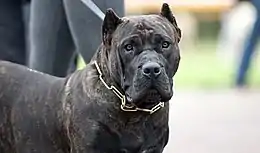Dogo (dog type)
Dogo, dogue, and dogge (from Spanish, French/Portuguese, and German, respectively) refer to a sub-type of dog, which represents a medium-sized intermediate between mastiffs and bulldogs. They were originally developed as catch dogs for large game. They were also used for baiting, and cattle work.[1][2][3][4] Typically, dogo-type dogs have a much lighter structure than mastiff-type dogs, and most of them have a longer muzzle, with the exception of the Dogue de Bordeaux.
Etymology
.jpg.webp)
The term dogo is Spanish,[3] derived from the Old English word docga.[5] Docga/dogo originally referred to hounds used to track and hold large game, and to guard estates. The meaning of the word has expanded over time to include dogs who also do other kinds of related work. This expansion of meaning has caused some conflation between the term dogo and the terms presa (Spanish, literally 'prey[ing]', 'catch[ing]') and fila (Portuguese, lit. 'seize/seizing') as applied to dogs. The Spanish dogos are sometimes known as presas;[4] for instance, the breed known in English by one of its Spanish names Dogo Canario is also called in Spanish presa canario, and the dogo mallorquín (usually known in English as the Ca de Bou from its Catalan name) is alternatively known by Spaniards as presa mallorquín (Spanish does not capitalize breed names). The extinct perro de presa español was closely related to them and might have been one of their ancestors (foundation stock). However, the Latin American dogos standardized breeds – Argentine Dogo or dogo argentino, Brazilian Dogo or dogue brasileiro, and Guatemalan Dogo or dogo guatemalteco – are not called presas because they have traditionally been used only as hunting and guard dogs, the original meaning of the term dogo. Presas and filas were often used as fighting, cattle, or butcher's dogs in addition to hunting and guarding.
In French and Portuguese, dogos are called dogues, and in German Dogges. Therefore, in Spanish, the Dogue de Bordeaux (its name in English as well as in French, which would not capitalize dogue) is known as dogo de Burdeos, and the Great Dane (Deutsche Dogge in German) as dogo alemán ('German dogo'). In addition, the Portuguese word fila is basically an equivalent for the word presa; a Portuguese dictionary published in 1813 explains the term cão fila as being "a dog that catches prey without releasing it",[6] referring to the same kind of catch-dog role as the Spanish dogos.[7]
In Spanish, French, and German, tipo dogo, type dogue or doggenartige Hunde (respectively) also refer to the whole mastiff-type dog subgroup of the FCI.[8][9] However, more massive and heavier mastiff breeds belonging to the same FCI subgroup are still usually called mastín, mâtin and Mastiff (Spanish, Portuguese, German).
Breeds
Actual dogos
The following breeds are counted as dogos or presas (filas):
- Dogo Argentino (from Spanish, for 'Argentine dogo'; French dogue argentin; German Argentinische Dogge)
- Dogue de Bordeaux (from French, 'dogue of Bordeaux'; Spanish dogo de Burdeos; German Bordeauxdogge)
- Brazilian Dogo (Portuguese dogue Brasileiro; Spanish dogo Brasileño)
- Dogo Canario (from Spanish, in which also perro de presa canario, referring to the Canary Islands; French dogue des Canaries)
- Dogo Cubano ('Cuban dogo'; extinct)
- Cordoba Fighting Dog (Spanish dogo de Cordoba) (extinct)
- Perro de presa español (extinct)
- Guatemalan Dogo (Spanish dogo guatemalteco)
- Perro de Presa Mallorquín (from Spanish, 'Mallorcan dogo'; Catalan ca de bou, 'bull dog'; French dogue de Majorque; German Mallorca-Dogge)
- Dogo Sardesco (from Spanish, 'Sardinian dogo')
- Saint Miguel Cattle Dog (Portuguese cão fila de São Miguel)
- Terceira Mastiff (Portuguese fila da Terceira; German Terceira-Dogge)[10] (extinct; being "re-created")
Other breeds of the dogo type
The following breeds are not called dogos, but in practical terms represent the same type and have related origins:
- Alano Español (from Spanish, 'Spanish mastiff'; German Spanische Dogge)
- Cane Corso (from Italian, 'Corsican hound')
- Perro bravo (Spanish, 'brave dog')
- Perro de presa boliviano (Spanish, 'Bolivian catch dog')
- Cimarrón Uruguayo (from Spanish, 'Uruguayan feral', though this name refers to a standardized breed which was simply developed from feral dogs as foundation stock)
References
- HogarMania - Molosos tipo dogo (Dogo-type molosser dogs) (in Spanish)
- TopperCan - Perros dogo (Dogo dogs) (in Spanish)
- MisAnimales - Cuantos tipo de perro dogo existen (How many dogo-type dogs exist?) (in Spanish)
- Molosos y Perros de presa (in Spanish) This tertiary source reuses information from other sources but does not name them.
- https://en.m.wiktionary.org/wiki/docga
- https://www.dicionarioinformal.com.br/significado/al%C3%A3o/27685/ (in Portuguese)
- Horter, R. (January 10, 2013). "Cao Fila de Sao Miguel – aka Saint Miguel Cattle Dog". The Canine Chronicle, Vol 306. Retrieved May 16, 2014.
- FCI. Grupo 2 Archived May 17, 2014, at the Wayback Machine. FCI. Retrieved May 16, 2014. (in Spanish)
- FCI. Gruppe 2 Archived May 17, 2014, at the Wayback Machine. FCI. Retrieved May 16th 2014. (in German)
- Krämer, E.-M. (2009). Der grosse Kosmos Hundeführer, s. 229. Kosmos: Stuttgart.
